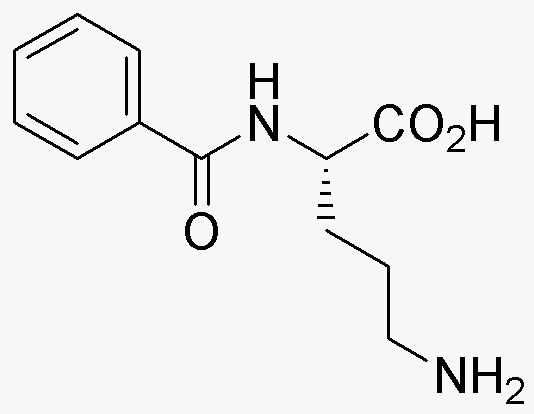Na-Benzoyl-L-ornithine is widely utilized in research focused on:
- Peptide Synthesis: This compound serves as a valuable building block in the synthesis of peptides, which are essential in drug development and biochemistry.
- Pharmaceutical Development: It plays a role in the formulation of pharmaceuticals, particularly in creating compounds that target specific biological pathways.
- Biochemical Research: Researchers use it to study protein interactions and enzyme activity, providing insights into various biological processes.
- Cosmetic Industry: Its properties are leveraged in the formulation of skincare products, where it can enhance skin penetration and efficacy of active ingredients.
- Diagnostic Applications: It is used in the development of diagnostic tools, particularly in assays that require specific binding interactions.
Informations générales
Propriétés
Sécurité et réglementation
Applications
Na-Benzoyl-L-ornithine is widely utilized in research focused on:
- Peptide Synthesis: This compound serves as a valuable building block in the synthesis of peptides, which are essential in drug development and biochemistry.
- Pharmaceutical Development: It plays a role in the formulation of pharmaceuticals, particularly in creating compounds that target specific biological pathways.
- Biochemical Research: Researchers use it to study protein interactions and enzyme activity, providing insights into various biological processes.
- Cosmetic Industry: Its properties are leveraged in the formulation of skincare products, where it can enhance skin penetration and efficacy of active ingredients.
- Diagnostic Applications: It is used in the development of diagnostic tools, particularly in assays that require specific binding interactions.
Documents
Fiches de données de sécurité (FDS)
La FDS fournit des informations de sécurité complètes sur la manipulation, le stockage et l’élimination du produit.
Spécifications du produit (PS)
Le PS fournit une description complète des propriétés du produit, notamment sa composition chimique, son état physique, sa pureté et les exigences de stockage. Il détaille également les plages de qualité acceptables et les applications prévues du produit.
Certificats d'analyse (COA)
Recherchez des certificats d'analyse (COA) en saisissant le numéro de lot du produit. Les numéros de lot et de lot se trouvent sur l'étiquette d'un produit, après les mots « Lot » ou « Lot de fabrication ».
Numéro de catalogue
Numéro de lot/série
Certificats d'origine (COO)
Ce certificat d'exploitation confirme le pays dans lequel le produit a été fabriqué, et détaille également les matériaux et composants utilisés et s'il est issu de sources naturelles, synthétiques ou autres sources spécifiques. Ce certificat peut être requis pour les douanes, le commerce et la conformité réglementaire.
Numéro de catalogue
Numéro de lot/série
Fiches de données de sécurité (FDS)
La FDS fournit des informations de sécurité complètes sur la manipulation, le stockage et l’élimination du produit.
DownloadSpécifications du produit (PS)
Le PS fournit une description complète des propriétés du produit, notamment sa composition chimique, son état physique, sa pureté et les exigences de stockage. Il détaille également les plages de qualité acceptables et les applications prévues du produit.
DownloadCertificats d'analyse (COA)
Recherchez des certificats d'analyse (COA) en saisissant le numéro de lot du produit. Les numéros de lot et de lot se trouvent sur l'étiquette d'un produit, après les mots « Lot » ou « Lot de fabrication ».
Numéro de catalogue
Numéro de lot/série
Certificats d'origine (COO)
Ce certificat d'exploitation confirme le pays dans lequel le produit a été fabriqué, et détaille également les matériaux et composants utilisés et s'il est issu de sources naturelles, synthétiques ou autres sources spécifiques. Ce certificat peut être requis pour les douanes, le commerce et la conformité réglementaire.


